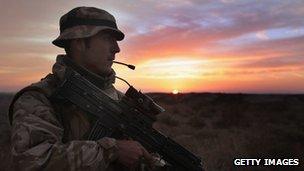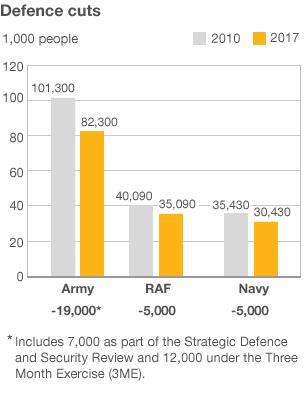MoD tells 4,000 military staff of job losses
- Published

More than 4,000 military personnel have received redundancy notices in the latest round of armed forces cuts.
About a third are compulsory redundancies in a second wave of job losses which follow 2,860 job cuts announced in August and September 2011.
It is the last major round of redundancies for the RAF and Royal Navy, but the army faces more job cuts.
The defence secretary says the cuts are to plug a black hole in the defence budget inherited by the government.
In this tranche, 2,900 posts will go from the Army, 900 from the RAF and 300 from the Royal Navy.
The MoD wants to cut 29,000 military and 25,000 civilian posts by 2015, to plug a £38bn defence budget gap.
The numbers revealed on Tuesday were announced by the MoD in January.
Meeting the challenges
About 17,000 armed forces jobs are scheduled to be cut under the terms of the Strategic Defence and Security Review (SDSR), announced in 2010.

The navy and air force have to cut 5,000 jobs each, the Army 7,000 and about 25,000 civilian staff working at the MoD face redundancy.
A further reduction of 12,000 army personnel was subsequently announced.
The result is that army numbers are likely to fall from 101,000 to 82,000 by 2015.
Defence Secretary Philip Hammond said he regretted the redundancies.
"We've now brought the defence budget back into balance for the first time in a generation. We will have smaller Armed Forces but we will ensure they will have the protection and equipment they need," he said.
He said no decisions had been taken on how the Army would be further cut.
Chief of the Defence Staff, General Sir David Richards, said he offered "sincere thanks" to those who were leaving the services, for their contribution to the nation's security.
"Some of you may see redundancy as an opportunity. Others will see it as a significant challenge. Your chain of command will support you during the redundancy process," he said.
'Quite painful'
Shadow defence secretary Jim Murphy said he was concerned about "the human and military impact" of job losses, and accused the government of "dithering".
He said: "Capability is being lost, as are people's livelihoods.
"Savings have to be made but ministers must do much more to explain our future ability to project force around the world as well as how they intend to support the thousands being sacked."
Former army head Lord Dannatt on "a risky strategy"
Lord Dannatt, a former head of the Army, said the scale of reductions would have an impact on the UK's ability to fight on multiple fronts.
"With great difficulty, the Army managed to put a force into the field in Iraq and Afghanistan simultaneously for an extended period of time between 2003 and 2009. It will be very difficult, verging on the impossible, to do that when the Army is down to 82,000 by 2020."
But Maj Gen John Lorimer, General Officer Commanding of the 3rd United Kingdom Division, said morale was high, with no change in the Army's operational capability.
"The Army has been through change before and we negotiated and got through and navigated through it pretty well. Yes, these things are not easy but we've been aware of the redundancy programme," he said.
He added that the army still needed to recruit to ensure new talent was being developed.
In the first wave of losses in August and September 2011 more than 2,800 personnel were told they had been selected for redundancy.
Almost two-thirds of those volunteered to leave the armed forces.
- Published17 January 2012
- Published13 January 2012
- Published19 October 2010